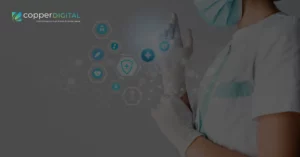In an era defined by technological advancements, the healthcare industry stands on the precipice of a profound transformation, and at the heart of this change lies the Internet of Medical Things (IoMT). As the world becomes increasingly interconnected, the convergence of medical devices, data analytics, and the power of the Internet has given rise to a new era in healthcare — one characterized by unprecedented access to real-time information, personalized patient care, and enhanced diagnostic and treatment capabilities.
The IoMT represents a groundbreaking evolution of the Internet of Things (IoT) specifically tailored to the healthcare sector. It encompasses a vast ecosystem of interconnected medical devices, wearables, sensors, and applications that collectively gather, transmit, and analyze patient data, fostering seamless integration of technology into the fabric of healthcare. The implications of this transformation are nothing short of revolutionary, promising to reshape how healthcare is delivered, monitored, and experienced by patients and practitioners alike.
In this blog, we will delve into the captivating realm intricacies of the IoMT and explore its far-reaching impact on the healthcare industry. We will look at its advantages, challenges, and real-world success stories, exploring how the IoMT is redefining healthcare as we know it.
Let’s start by enfolding what exactly this IoMT is.
What Is IoMT?
The Internet of Medical Things involves the interconnection of medical devices and applications through the Internet, facilitating the collection, exchange, and analysis of data to monitor patient health, enhance diagnostics, and improve medical treatment. This connectivity enables wearable devices, smart sensors, and medical equipment to communicate seamlessly, offering a comprehensive real-time perspective on a patient’s well-being. The interdependence forms the foundation of IoMT, propelling healthcare into a new era characterized by heightened efficiency and effectiveness.
Examples of IoMT Devices and Applications in Healthcare

Wearable Health Trackers: Devices like fitness bands and smartwatches are no longer limited to counting steps. Moreover, they can monitor heart rate, sleep patterns, and blood glucose levels. This data can then be transmitted to healthcare professionals, enabling them to provide personalized recommendations and interventions.
Remote Patient Monitoring Systems: IoMT facilitates continuously monitoring patients with chronic conditions. This enables healthcare providers to receive real-time data about vital signs, medication adherence, and symptom changes. Consequently, this leads to timely interventions, ultimately reducing hospital readmissions and enhancing patient outcomes.
Smart Medical Devices: From insulin pumps that adjust dosages based on glucose levels to pacemakers that transmit data on heart health, smart medical devices are redefining patient care. These devices improve treatment effectiveness and enhance patient safety by providing early warnings of potential issues.
IoMT, while similar to IoT, is uniquely designed for healthcare. Its devices adhere to strict medical regulations due to data sensitivity. It focuses on device compatibility and seamless patient data transfer. This medical science and technology convergence could revolutionize healthcare, boosting personalization and efficiency. IoMT’s benefits go beyond convenience, enhancing patient care, diagnostics, and healthcare delivery.
Also, Read – The Transformative Power of Machine Learning in Healthcare
Advantages of IoMT in Healthcare
Integrating IoMT into healthcare offers benefits across patient care, diagnostics, treatment, and operational efficiency, elevating service quality and transforming healthcare delivery and management.

Enhanced Patient Care and Monitoring
- Real-Time Patient Monitoring and Data Collection: IoMT enables healthcare providers to remotely monitor patients’ vital signs, chronic conditions, and health metrics in real time. This ongoing data collection allows for early detection of health deviations, enabling timely interventions and lowering complication risks.
- Remote Patient Management and Telemedicine: Patients can access medical care and consultations remotely through IoMT-powered telemedicine platforms. These platforms allow video consultations with doctors, sharing health data, and receiving treatment recommendations at home. This is especially advantageous for people with mobility constraints or living in remote regions.
- Early Detection and Prevention of Health Issues: IoMT can identify potential health risks and anomalies before they escalate into critical conditions by tracking trends and patterns in patient data. Physicians can proactively intervene to prevent disease progression, improve patient outcomes, and reduce healthcare costs.
Improved Diagnostics and Treatment
- Data-Driven Insights for Accurate Diagnoses: IoMT generates large volumes of patient data, including biometrics, lifestyle habits, and historical medical records. Analyzing this data with advanced algorithms and AI can lead to more accurate diagnoses, reducing errors and enabling personalized treatment plans.
- Personalized Treatment Plans Based on Patient Data: The wealth of patient data gathered through IoMT devices allows healthcare providers to tailor treatment plans to each individual’s unique needs. This personalized approach enhances treatment efficacy and patient adherence, ultimately improving health outcomes.
- Integration of IoMT with Medical Imaging and Diagnostics: IoMT can seamlessly integrate with medical imaging devices, such as MRI and CT scanners, enabling real-time monitoring during procedures. This integration enhances the accuracy of diagnoses and provides clinicians with immediate feedback, improving the quality of care.
Efficient Hospital Operations
- Asset and Inventory Tracking: IoMT facilitates the tracking and managing of medical equipment, supplies, and assets within healthcare facilities. This leads to efficient resource allocation, reduced equipment downtime, and minimized wastage of resources.
- Streamlined Workflows and Resource Allocation: IoMT can optimize hospital workflows by automating routine tasks, such as patient registration, appointment scheduling, and billing. This frees healthcare professionals to focus on patient care and complex medical decisions.
- Predictive Maintenance of Medical Equipment: IoMT-enabled devices can monitor the performance and condition of medical equipment in real-time. Predictive maintenance algorithms can detect potential malfunctions or issues, allowing maintenance teams to address problems before they lead to equipment failure.
The benefits of IoMT in healthcare go beyond convenience, including enhanced patient outcomes, streamlined operations, and cost savings. IoMT is more than a technological shift – it’s a transformative shift that elevates care quality and revolutionizes the healthcare experience for all involved.
How to Successfully Implement IoMT Technology in Healthcare
While the potential benefits of Internet of Medical Things (IoMT) technology in healthcare are substantial, successful implementation requires careful planning, collaboration, and adherence to best practices. Here’s a comprehensive guide on how healthcare organizations can navigate the complexities of IoMT adoption to reap its rewards effectively.

Develop a Clear Strategy and Vision
- Identify Goals: Define specific goals for adopting IoMT technology, such as enhancing patient care, improving operational efficiency, or advancing diagnostics.
- Leadership Involvement: Secure support from top-level executives to ensure alignment with the organization’s overall mission and objectives.
- Cross-Functional Collaboration: Establish a multidisciplinary team that includes IT experts, medical professionals, data analysts, and regulatory experts to shape the IoMT implementation strategy collectively.
Ensure Data Security and Compliance
- Regulatory Compliance: Understand and adhere to relevant regulations such as HIPAA, GDPR, and medical device regulations to ensure patient data security and privacy.
- Secure Communication Protocols: Implement robust encryption and secure communication protocols to safeguard data transmitted between IoMT devices and healthcare systems.
- User Authentication and Authorization: Implement strong user authentication measures to ensure only authorized personnel can access sensitive patient data.
Choose the Right IoMT Devices and Solutions
- Device Selection: Choose IoMT devices and solutions that align with your healthcare organization’s needs and goals. Consider factors like ease of integration, compatibility, and scalability.
- Interoperability: Opt for devices and systems that can seamlessly communicate with existing electronic health records (EHR) and other healthcare IT systems.
- Reliability and Quality: Prioritize devices with proven reliability, accuracy, and quality standards, especially for critical applications like diagnostics and patient monitoring.
Plan for Data Integration and Analytics
- Data Integration: Develop a strategy for integrating IoMT-generated data into existing healthcare systems, including EHRs and data warehouses.
- Analytics Capabilities: Implement data analytics tools to process and derive meaningful insights from the large volumes of data IoMT devices generate.
- Real-Time Monitoring: Set up alerts and notifications for abnormal data patterns, enabling healthcare providers to respond promptly to critical situations.
Address Interoperability Challenges
- Standardization: Advocate for industry-wide communication protocols and data standards to ensure interoperability between different IoMT devices and vendors.
- Vendor Collaboration: Work closely with IoMT device vendors to ensure seamless integration and interoperability within your healthcare ecosystem.
- API Integration: Utilize open APIs (Application Programming Interfaces) to facilitate data exchange between IoMT devices and healthcare systems.
Train and Educate Personnel
- Healthcare Workforce Training: Provide comprehensive training to healthcare professionals on using and interpreting data from IoMT devices.
- IT Team Skills: Equip IT staff with the skills required to manage IoMT infrastructure, data security, and integration.
Pilot Testing and Continuous Improvement
- Pilot Projects: Start with smaller pilot projects to test IoMT implementations, gather feedback, and identify potential challenges.
- Iterative Approach: Embrace an iterative approach, continuously refining the IoMT strategy based on real-world experiences and feedback.
Patient Engagement and Education
- Patient Education: Educate patients about the benefits of IoMT technology.
- Privacy Transparency: Ensure patients know how their data will be collected, stored, and used and obtain their informed consent.
Effectively utilizing IoMT technology in healthcare demands a carefully planned strategy, teamwork, and flexibility. By managing data security, interoperability, and engaging stakeholders, organizations can leverage IoMT to enhance overall operational efficiency.
Also, Read – The Benefits of Using Chatbots in Healthcare: A Comprehensive Overview
Conclusion
The landscape of healthcare is undergoing a transformative shift with the advent of the Internet of Medical Things. IoMT empowers patients to take charge of their health and facilitates seamless communication between patients and healthcare providers. This promising trajectory holds the potential for advanced remote patient monitoring, personalized treatment regimens, and enhanced healthcare outcomes.
By developing a clear strategy and partnering with a renowned healthcare software development company, healthcare institutions can effectively harness IoMT’s potential.
Data security, compliance, and device integration ensure patient privacy, trust and harness real-time monitoring for personalized care.
Overcoming interoperability challenges and ensuring data exchange through open APIs fosters a seamless IoMT ecosystem. Educating and training medical and IT personnel pave the way for successful implementation and ongoing management. Pilot projects and a commitment to continuous improvement drive refinement, ensuring the technology’s full potential is realized.
Successful implementation of IoMT enhances patient outcomes and propels healthcare into a new era of precision, efficiency, and patient-centered care. By embracing IoMT, organizations stand poised to revolutionize how they deliver services and, ultimately, elevate the well-being of patients worldwide.




